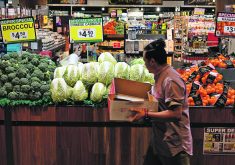Glacier FarmMedia – Canadians may hope the new Canadian Grocery Code of Conduct will result in a fairer, more transparent food system, but producers at the base of the value chain still have some concerns.
For one thing, it’s a voluntary agreement. Only retailers and suppliers that sign on must adhere to the rules, said Melanie Boldt, co-owner of Pineview Farms north of Saskatoon.
“It doesn’t have teeth. Their arbitration process is not yet defined and there’s so many questions that need to be ironed out.”
Read Also

Manitoba extends Crown land rent freeze
Manitoba government links the continued rental rate freeze on grazing and forage leases to economic and environmental challenges facing the industry
The code formalizes standards for how participating grocers do business with processors, suppliers and food manufacturers, which affects the business environment for farmers.
Pineview Farms won’t be affected by the code. It closed earlier this year after 26 years as a fully integrated all-natural meat and poultry producer, processor and marketer. Its products appeared in health food stores, butcher shops and Saskatchewan Co-ops and were offered through direct sale.
A farm like theirs was lucky to get into co-ops, Boldt said. Grocery chains can offer a much bigger customer base and geographic range, but they’re tough to break into for small producers or food manufacturing companies.
“In my experience, most grocery chains, the larger ones, they all want local products. They all say that. But the protocols and processes they put in place to actually get listed (with them) prevent that for most small-scale processors because, in the meat business anyway … they basically require federal inspection.”
The cost of getting access to grocery chains and the hassle of staying there is one thing local manufacturers hoped the code would address. Michael Mikulak, executive director of Food and Beverage Manitoba, pointed to issues such as shelving fees during a 2022 interview with the Manitoba Co-operator. His organization represents Manitoba’s agri-food manufacturers.
“Some of those barriers really do need to get reduced if we are to value a more local, resilient food system in the future,” he said.
At the time of that interview, the code development process had stalled in Ottawa. It had been in the works since 2021, after pandemic pressures on the supply chain brought grocer practices and centralization of ownership among big chains like Loblaw, Metro, Sobeys, Walmart and Costco into the limelight.
Spiking food inflation kept the issue top of mind.
By September 2022, however, code development had blown past two deadlines and faced another that November. It was still working to overcome stalemates over fines, contractual obligations in the case of unforeseen circumstances and cost indexing.
The 10-stakeholder steering committee spearheading the effort (which included such agricultural names as the Canadian Federation of Agriculture, Dairy Producers Association of Canada and Fruit and Vegetable Growers of Canada), moved to an interim board of directors in November 2023. In January, that board released the current wording of the code.
That version is voluntary, despite a previous position from the old steering committee that it be mandatory.
“The success of the Grocery Code of Conduct depends on the involvement and support of all major grocery retailers,” a statement on the code’s website reads. “There have been concerns about potential market imbalances if not all key players participate.”
On May 16, Loblaw Companies Limited announced its participation.
Boldt doesn’t disregard the code entirely, noting it could improve the situation for producers and processors.
It won’t shield them from all issues though. She suggests that businesses educate themselves on retailer practices, contracts and fees, including shelf-stocking, black box margin and potential clauses for orders and delisting.
“You need to know what you’re agreeing to, because this process only arbitrates the contract you already have in place. You have to negotiate and understand what you’re committing to, what your outs are and what they, the retailer, is committing to you.”
Boldt said she hopes that, with more work and wide acceptance by grocers, the code can be used as a dispute mechanism.
Patrice Léger Bourgoin, Fruit and Vegetable Growers of Canada representative on the code’s interim board, agreed that more work is needed, but said the document is only the beginning of the precedent-setting arrangement throughout the value chain.
“It’s the opportunity to have a very honest and transparent conversation on what were the impacts of the decisions made by retailers, the opportunity to start a real and longstanding conversation,” he said.
His group represents vegetable producers across Canada who supply the five major chains that are the primary targets for the code. Bourgoin said growers are aligned to a single mandate for support of the code, allowing for strong negotiation with retailers.
There were high hopes in the code’s early days, he said, but negotiations are always a process of give and take.
“You have to leave (a) couple of things on the table and I said I’m willing to give up on many fundamental items. But, on the other hand, we’ll start the code because we need to start somewhere and to demonstrate to stakeholders that it works.”
The end result must be similar to the U.K. model, upon which Canada based its version, he added. There must be strong leadership for roll out, available reports and information for the public and reviews for improvement. Not everyone will be happy right away, but regulation is needed, Bourgoin said.
“On the supplier’s side, we had a discussion together and the mutual sense was we have nothing to lose to start a voluntary process and (re-evaluate) in two years.
“I’m proud of the code. Is it perfect? The answer is definitely no. Is it better than the actual situation? The answer is definitely yes.”
















